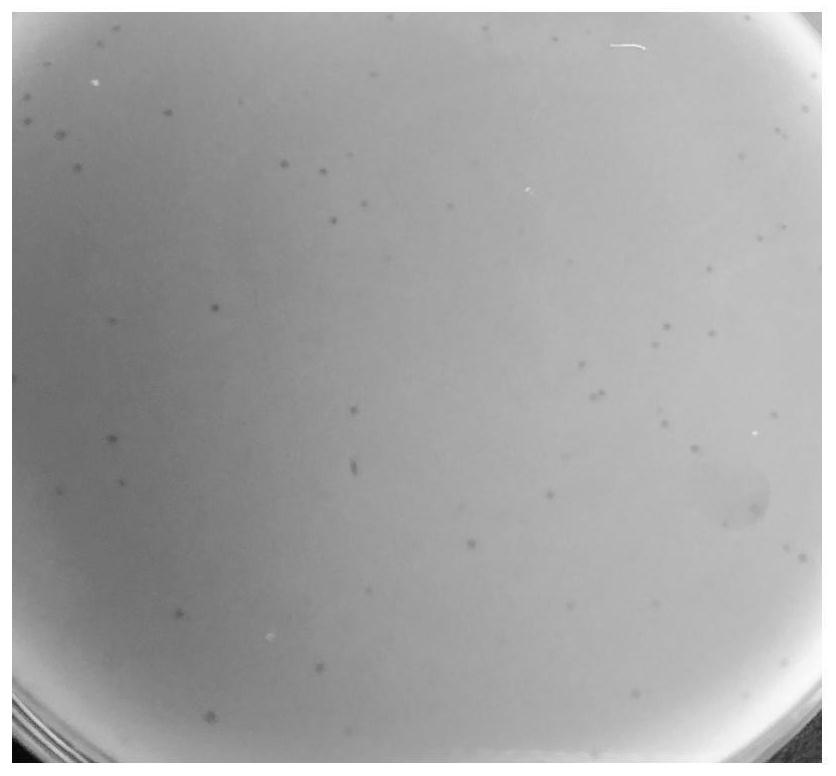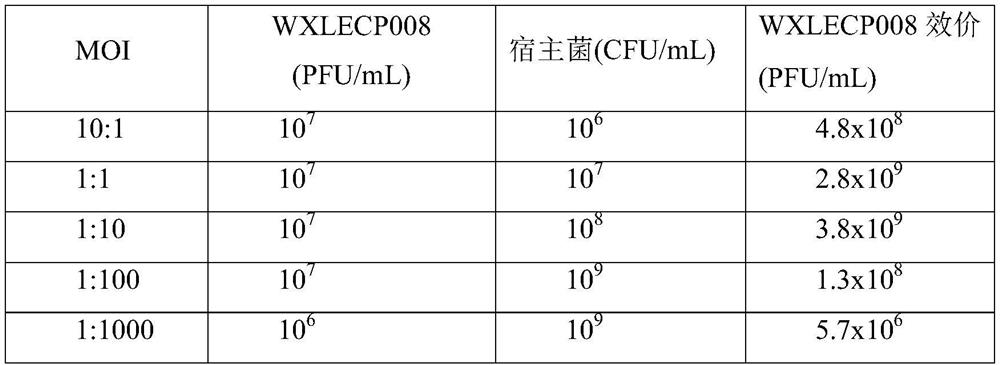Broad-spectrum escherichia coli phage and application thereof
A technology of Escherichia coli and bacteriophage, applied in the direction of bacteriophage, virus/bacteriophage, application, etc., can solve the problems of increased expenditure and crisis in the medical and health industry, and achieve the effect of excellent strain resources, wide host range, and good application development prospects.
- Summary
- Abstract
- Description
- Claims
- Application Information
AI Technical Summary
Problems solved by technology
Method used
Image
Examples
Embodiment 1
[0044] Example 1 Isolation and Purification of Escherichia coli Phage WXLECP008
[0045] Collect 10 samples of sewage near a chicken farm in Hubei, each 20mL, centrifuge at 5000rpm for 10min, take 10mL supernatant and sterilize it, mix it with 10mL 2×TSB liquid medium and 2mL Escherichia coli WXLEC008 in logarithmic phase Liquid (10 8 cfu / mL) were evenly mixed, and cultured overnight at 180 rpm at 37°C to enrich the phage. The sample enrichment solution was centrifuged at 5000 rpm for 10 min, and the supernatant was sterilized through a 0.22 μm microporous membrane to obtain a filtrate containing phage. Take 100 μL of the filtrate and mix it evenly with 300 μL of the host Escherichia coli liquid, and let it stand for 15 minutes to fully bind with the receptors on the surface of the bacteria. Add the above mixed solution to 4mL TSB semi-solid agar medium cooled to 50°C, spread it on the solidified TSA plate immediately after mixing, and incubate upside down at 37°C for 8-12 h...
Embodiment 2
[0046] Example 2 Determination of coliphage WXLECP008 titer
[0047] Make diluent with SM liquid, the stoste 10 times gradient of coliphage WXLECP008 (made by embodiment 1) is diluted step by step to 10 8 times. Take l0 respectively 5 , l0 6 , l0 7 and l0 8 0.1 mL of the diluted phage culture solution was evenly mixed with 500 μL of the host bacterium (Avian Nonpathogenic Escherichia coli (ANPEC)) Escherichia coli WXLEC008, and allowed to stand for 15 minutes to allow it to fully bind to the receptors on the surface of the bacteria. Add the above mixed solution to 4 mL of TSB semi-solid agar medium cooled to 50°C, mix well and spread it on the solidified solid agar plate immediately, and incubate it upside down at 37°C for 8-12 hours after the agar solidifies. Three parallel samples are required for each dilution, and the average of the three parallel samples of this dilution is used for counting. Among them, phage titer (PFU / mL) = average number of plaques × dilution fa...
Embodiment 3
[0051] Example 3 Determination of coliphage WXLECP008 to the optimal multiplicity of infection (MOI) of Escherichia coli
[0052] A single colony of Escherichia coli was picked, inoculated into a bacterial bottle containing 3 mL of TSB culture solution, and shaken at 180 rpm in a shaker at 37°C for 12 hours to obtain a host bacterial suspension. The bacterial suspension was transferred to 10 mL TSB culture medium at a ratio of 1:100, and cultured with shaking at 180 rpm at 37°C to the pre-logarithmic phase. Add the pure culture solution of phage WXLECP008 (prepared in Example 1) and host bacteria (MOI=number of phages / number of bacteria) according to the multiplicity of infection ratio, and add TSB liquid medium to make the total volume of each tube the same. Shake overnight at 180 rpm in a shaker at 37°C. After the culture was completed, centrifuge at 5000 g for 10 min and collect the supernatant to measure the phage titer. Each point was cultured in duplicate and the avera...
PUM
 Login to View More
Login to View More Abstract
Description
Claims
Application Information
 Login to View More
Login to View More - R&D
- Intellectual Property
- Life Sciences
- Materials
- Tech Scout
- Unparalleled Data Quality
- Higher Quality Content
- 60% Fewer Hallucinations
Browse by: Latest US Patents, China's latest patents, Technical Efficacy Thesaurus, Application Domain, Technology Topic, Popular Technical Reports.
© 2025 PatSnap. All rights reserved.Legal|Privacy policy|Modern Slavery Act Transparency Statement|Sitemap|About US| Contact US: help@patsnap.com



